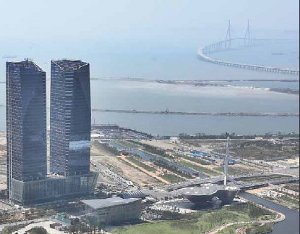Corée
Green growth in action: Korea
|
Korea has been at the forefront of green growth initiatives. The National Strategy for Green Growth (2009-2050) and the Five-Year Plan (2009-2013) of Korea provide a comprehensive policy framework for green growth in both the short and long term. In the long term, the National Strategy for Green Growth aims to:
The Five-Year Plan outlines government actions for implementation of the Strategy, and detailed tasks for ministries and local governing entities as well as specific budgets. Under the plan, the government will spend approximately 2% of annual GDP on green growth programs and projects. Investments will initially be geared towards infrastructure systems in order to boost the economy. |
New Songdo City (Korea): Located on a man-made island 40 miles from Seoul, the 1,500-acre city is intended to emit only onethird the greenhouse gases of a similar size city and become the commercial hub of Northeast Asia. |
Over time, the government aims to become a leading exporter in the area of green research and technology. In line with this plan, Korea has passed a USD 30.7 billion stimulus package aimed to support its green ambitions. This included renewable energy resources, energy efficient buildings, expanding of railway systems and improving waste management. Projected benefits include increasing employment in green sectors, improved income and energy security as well as significantly reducing greenhouse gas emissions.
Four Rivers
The Four Major Rivers Restoration Project is an example of green growth in action. As well as improving water quality in the Han, Nakdong, Geum and Yeongsan Rivers, the project aims to create multipurpose spaces for local residents and enhance regional development around rivers.
The project will enable the creation of waterways resistant to floods and droughts through reinforced riverbanks, redeveloped reservoirs and by restoring the ecosystem. By expanding sewage treatment facilities and establishing green algae reduction facilities around the rivers, the Korean government hopes to achieve an 90% increase in water quality. Restoring indigenous and endangered aquatic species is another objective of the project. More than 900 km of national streams will be restored, and an estimated 35 riparian wetlands will be forested or reforested and will also be used for biomass production.
This long-term project aims to stimulate local economies through job creation. Ministry of Labour analysis shows the employment effects to be equivalent to KRW 7.37 trillion from 2009 to 2010 for 2 years, creating job opportunities for 88,400 workers. Cultural and tourism activities near rivers are designed to boost local employment while contributing to the revitalisation of the national economy. In total the project aims to create 340,000 jobs and generate an estimated KRW 40 trillion of economic benefits.
Green growth indicators in Korea
Korea has become the third country to issue a report using the proposed OECD green growth indicators. The 2012 report by Statistics Korea, Korea’s Green Growth, applies 23 indicators to evaluate the implementation of Korea’s green growth policies since 2000. The report shows that environmental and resource productivity, including CO2 emissions productivity, energy productivity and domestic material consumption has improved since 2000, but that recent years could have expected better performance.
Among the indicators from the natural asset base, water resources are insufficient, and the area of forest and wooded land has consistently decreased. Despite these decreases, timber stock and biological resources have steadily increased. Indicators on the environmental quality of life, including the share of population connected to sewage treatment and with access to safe drinking water, urban green space, and population exposure to urban air pollution have been improving since 2000.
Finally, the group of indicators on the economic opportunities and policy responses including R&D expenditure related to green growth, and the share of green ODA are rapidly improving with the full-scale green growth policies adopted in 2009. In general, the indicators show that Korea is moving towards a greener economy.
OECD publications
- Compact City Policies: Korea-Towards Sustianable and Inclusive Growth (November 2014)
- Economic Survey of Korea 2010 - Chapter 5. Korea’s green growth strategy: mitigating climate change and developing new growth engines.
- Environmental Impacts of International Shipping: A Case Study of the Port of Busan: Report (2010)
- The Implementation of the Korean Green Growth Strategy in Urban Areas (Regional Development Working Paper) (2011)
- Korea's green growth strategy: mitigating climate change and developing new growth engines, Economics Department Working Papers, no 798 (2010)
Sources
- A Compilation of Green Economy Policies, Programs, and Initiatives from Around the World, World Resources Institute (2011)
- Korea’s Green Growth: based on OECD Green Growth Indicators, Statistics Korea (2012)
- The Four Major Rivers Restoration Project, Office of National River Restoration (2011)
- Towards Green Growth: A summary for policy-makers, OECD (2011)
Documents connexes
